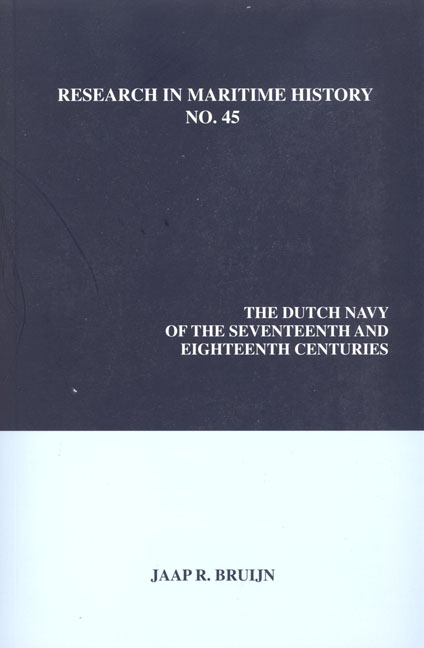Book contents
- Frontmatter
- Contents
- Illustrations
- Tables
- Series Editor's Foreword
- About the Author
- Introduction to the 2011 Edition
- Foreword
- Preface
- Introduction
- Map of the Dutch Republic
- Map of Dutch Naval Activity in European Waters
- Part One The “Old” Navy, Late 1500s-1652
- Part Two The “New” Navy, 1652-1713
- Part Three A Second-Rate Navy, 1714-1795
- In Retrospect
- Bibliography
- Index
Series Editor's Foreword
- Frontmatter
- Contents
- Illustrations
- Tables
- Series Editor's Foreword
- About the Author
- Introduction to the 2011 Edition
- Foreword
- Preface
- Introduction
- Map of the Dutch Republic
- Map of Dutch Naval Activity in European Waters
- Part One The “Old” Navy, Late 1500s-1652
- Part Two The “New” Navy, 1652-1713
- Part Three A Second-Rate Navy, 1714-1795
- In Retrospect
- Bibliography
- Index
Summary
Maritime history for too long has suffered from an unfortunate and artificial bifurcation between the military and non-military aspects of the relationship between humankind and the sea. The artificial separation between naval history and the rest of the discipline has impoverished us all. Despite the work of Ralph Davis, Basil Greenhill and N.A.M. Rodger, among others, naval history and the other branches of maritime history have developed in very different ways, often in isolation and to the detriment of scholarship. Naval and maritime historians have too often written in almost complete ignorance of what scholars in other parts of the discipline have contributed. The result is a frustratingly incomplete and often unsatisfying picture of the past.
Maritime history has also suffered from the strictures imposed by national historiographies. Since most historians have been, and still are, trained first and foremost in the history of a single nation, the different intellectual and methodological approaches to the study of the past in various countries have influenced the questions they ask and the ways in which they have attempted to answer them. Since The Dutch Navy of the Seventeenth and Eighteenth Centuries was written by a scholar who was educated and spent his entire career teaching in The Netherlands, it is useful to consider briefly how three Dutch historiographical traditions have shaped this book.
One of the most impressive features of Dutch scholarship has been a refusal to accept the artificial separation between naval history and other areas of maritime history. No scholar exemplifies this better than Jaap Bruijn. A glance at the huge body of scholarship he has produced makes it abundantly clear that he has never accepted the logic behind the chasm which colours and often disfigures so much of maritime history. Jaap has written about many things in his long and illustrious career, but among the myriad of topics he has examined, two stand out: the histories of East India Company (VOC) and the Dutch navy. That a scholar would presume to master two such disparate topics - one a commercial enterprise and the other a military activity - would be seen as unique, and perhaps foolhardy, in many other nations. But for Jaap, there is a compelling logic behind this: it is impossible, as his body of scholarship demonstrates so eloquently, to understand one without comprehending the other.
- Type
- Chapter
- Information
- The Dutch Navy of the Seventeenth and Eighteenth Centuries , pp. xiii - xivPublisher: Liverpool University PressPrint publication year: 2011



